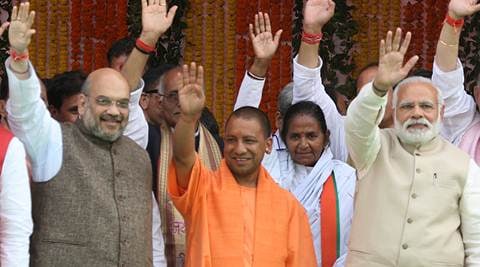
Uttar Pradesh’s Political Narratives: Truth or Tactics?
A State Shaped by its Political Stories
In Uttar Pradesh (UP), the heart of India’s democracy, political narratives wield enormous power. Whether they revolve around development, identity, or governance, these stories shape voter sentiment and electoral outcomes. But how much of this rhetoric reflects truth, and how much of it is cleverly crafted tactics aimed at consolidating power?
Key Themes Driving UP’s Political Narratives
1. Bipolar Politics: The Shrinking Space for Smaller Players
The once fragmented political landscape of UP has gradually consolidated into a battle between two primary forces: the Bharatiya Janata Party (BJP) and the Samajwadi Party (SP).
- Narrative: Both parties frame this consolidation as a necessary step to simplify governance and decision-making.
- Reality: The diminishing relevance of parties like the Bahujan Samaj Party (BSP) and Congress raises questions about the diversity of political representation. Smaller caste-based parties struggle to maintain their identity amidst this polarization.
2. Development as a Political Currency
Infrastructure projects like the Purvanchal Expressway, the Bundelkhand Expressway, and the ambitious Jewar Airport have become key talking points in the BJP’s development narrative.
- Claim: The state government positions these projects as evidence of progress, economic revival, and job creation.
- Criticism: While urban centers see rapid progress, rural areas often remain disconnected from such initiatives, perpetuating regional disparities. Development is perceived as a selective strategy to bolster electoral prospects.
3. Caste Politics: A Reinvented Strategy
UP’s deeply entrenched caste dynamics continue to dominate the political narrative, albeit in new forms.
- SP’s Stand: The Yadav-Muslim coalition remains the party’s backbone, with Akhilesh Yadav attempting to expand his reach to non-Yadav OBCs.
- BJP’s Play: By incorporating non-Yadav OBCs and non-Jatav Dalits, the BJP has successfully fractured traditional vote banks.
- Question: While leaders claim to focus on development for all, caste considerations often overshadow broader socio-economic issues.
4. Religious Narratives and Polarization
Religion continues to be a potent force in UP’s politics, often shaping electoral strategies and public discourse.
- Narrative: Projects like the Ram Mandir in Ayodhya and the Kashi Vishwanath Corridor are positioned as cultural renaissance efforts.
- Criticism: Actions such as restrictions on minority businesses during festivals raise concerns about religious polarization being used as a political tool.
Recent Narratives: Truth or Tactics?
1. The Myth of Rural Prosperity
Despite campaigns that claim rural upliftment, poverty and unemployment remain significant challenges. Schemes like One District, One Product (ODOP) aim to empower rural industries but face criticism for limited impact on marginalized communities.
2. Women’s Empowerment or Electoral Strategy?
Initiatives like Mission Shakti focus on women’s safety and financial independence. While they symbolize progress, the question arises: Are these measures sustainable solutions, or are they tactical gestures aimed at gaining women’s votes?
3. The Opposition’s Role
The SP positions itself as a voice for inclusivity and governance but struggles with internal cohesion and limited outreach beyond its core voter base. The BSP and Congress remain largely peripheral, questioning the authenticity of opposition narratives.
Impact on Voters: Are Narratives Creating Lasting Change?
- Development Disconnect
- Urban centers thrive, but rural voters often feel excluded from the larger developmental agenda.
- Caste and Religion Fatigue
- Voter fatigue with identity politics is growing, particularly among younger generations, who demand focus on employment and education.
- Empowered Women Voters
- Women’s increasing electoral participation challenges parties to prioritize gender-sensitive governance.
Looking Ahead: Breaking the Narrative Trap
- Focus on Inclusive Development
- Policies must bridge the rural-urban divide and benefit all communities equally.
- Strengthen Opposition Accountability
- A robust opposition is essential to counterbalance dominant narratives and provide alternative governance models.
- Move Beyond Identity Politics
- Caste and religion-based appeals need to give way to issue-based politics focused on employment, education, and healthcare.
- Engage Youth in Governance
- Political leaders must prioritize programs that address the aspirations of UP’s young population.
Conclusion
The political narratives in Uttar Pradesh are a mix of truth and tactics. While progress in infrastructure and governance shows promise, the selective use of development stories and identity politics raises questions about inclusivity and sustainability.
For UP’s democracy to flourish, it is imperative that political narratives evolve from tactical posturing to authentic governance, addressing the needs of every section of society. Only then can the state realize its potential as a leader in India’s democratic and developmental journey.


